Jack Butler Yeats RHA (1871-1957)
I Will Not Sit on the Grass, She Said
Indian ink and watercolour, 11.3 x 15cm (4½ x 6")
Signed
Provenance: With the Dawson Gallery, Dublin; Sale, Sotheby's London 10/06/81, Lot 158, where purchased by the present owner.
Jack B. Yeats produced his greatest volume of watercolour work during a period (c. 1897-1910) when he was also very active as a cartoonist and illustrator. So, as much as the eye is drawn to the vivid application of finely judged colour, it is the boldness of line, the clarity in the rendering, and occasionally also the humour, that characterizes much of this collection. The skills of draughtsmanship which he undoubtedly possessed had been honed, without tuition, during the hours of obsessive sketching and doodling with which he had occupied himself from an early age. He excelled as a black-and-white artist, and producer of fine watercolours and drawings, during the period that preceded his entry into the world of oil painting with which he is more commonly associated (though he would continue to produce work in all these areas for many years). He was living in England, the country of his birth, throughout this time, and one can detect traces of some of the great English graphic artists, such as George Cruikshank and Phil May, though he evolved an idiosyncratic and recognizable style all his own from early on. A hint of the bizarre, suggestive of Francisco Goya or James Ensor add a mysterious flavour to works such as the wonderful pencil and watercolour piece, Blue Jackets in Fancy Dress, also known as Men-o-Wars in Fancy Dress (Costume),(Lot 52) which depicts an unusual group of figures ascending a quayside ladder in Dartmouth.
There were regular trips back to Ireland, and in dozens of compact sketchbooks he documented the characters and incidents of small-town life, many related to fairgrounds and to horse racing. Hilary Pyle tells us that these sketches, themselves often in ink and watercolour, would form the basis of larger works completed at home in his Devon hideaway, Cashlauna Shelmiddy. Losing nothing in the transition, the finished works retain the spontaneity and raw spark of the quickly rendered sketchbook drawings. Horses appear in a number of the pictures in this collection (The Race (Lot 47); The Baker Rode a Pie-Bald (Lot 51)), and they would be central to his art throughout his life. They could function metaphorically, particularly in the later work, but Yeats could also be more direct in his celebration of their sheer physicality, power, and speed. He was equally fascinated by the enigmatic riders, steely-eyed protagonists in many drawings and paintings, and by the bustle of the social worlds in which they moved. The beautifully observed pen and ink drawing of The Crown and Anchor Man (Lot 48) is typical of the unique characters- the street performers and race day vendors, circus and fairground entertainers- to whom Yeats was repeatedly drawn during this period.
Yeats’s first solo exhibition of watercolour sketches, the majority of which were executed in Devon, was held at the Clifford Gallery in London in 1897. In 1899 he held another exhibition of his work, titled “Sketches of Life in the West of Ireland,” at the Walker Art Gallery, again in London, repeated later that year at Leinster Hall in Dublin. Throughout this period Yeats alternated between galleries in these two cities, averaging one solo show annually up to 1914. He subscribed to a press cuttings agency- Romeike and Curtice of the Strand- and pasted his notices and reviews into a scrapbook, which attests to the largely positive response that his watercolour work received at the time. A critic for the Daily Express, on visiting the first Dublin show, wrote that “(n)o one, it seems to us, has studied the humbler side of Irish life with such insight and intelligence, and certainly no Irish artist has ever given us so graceful and fresh a representation of its pathos and humour.” Commenting on another Dublin exhibition two years later, a reviewer for the United Irishman remarks, with some prescience, that “these pictures will some day be looked upon as important historical records.” Indeed there is an almost documentary approach to many of his subjects, unsurprising given the journalistic collaborations with J.M. Synge that saw them render, in prose and illustration, the rawness of life in Mayo and Connemara for the Manchester Guardian in 1905.
Yeats would return again and again to the rural sites of sporting competition and public entertainment, often with an eye for the onlookers, as in the busy and endlessly appealing composition of A Good Winner (Lot 50). Many works from this period combine observation from real life with the mischievous caricatural twist that typified much of the material he was also producing for the humour periodicals and early comics. The suggestion of gently ribald comedy in I will not sit on the grass, she said (Lot 46) exemplifies the playful interplay between caption and image that Yeats imported into the art gallery from those popular contexts. The strong outlines and striking compositions evident in these pieces, for example Figure of a Young Woman in a Landscape (Lot 53) and Beggar at the Door (Lot 49), also recall the well-known drawings that appeared in printed form in the series A Broad Sheet (1902-03) and later A Broadside (1908-1915) published respectively in London by Elkin Mathews and in Dublin by Dun Emer/Cuala Press.
Michael Connerty, April 2023
Lit: Hilary Pyle. Jack B. Yeats- His Watercolours, Drawings and Pastels. Dublin: Irish Academic Press. 1992
Jack Butler Yeats RHA (1871-1957)
I Will Not Sit on the Grass, She Said
Indian ink and watercolour, 11.3 x 15cm (4½ x 6")
Signed
Provenance: With the Dawson Gallery, Dublin; Sale, Sotheby's London 10/06/81, Lot 158, where purchased by the present owner.
Jack B. Yeats produced his greatest volume of watercolour work during a period (c. 1897-1910) when he was also very active as a cartoonist and illustrator. So, as much as the eye is drawn to the vivid application of finely judged colour, it is the boldness of line, the clarity in the rendering, and occasionally also the humour, that characterizes much of this collection. The skills of draughtsmanship which he undoubtedly possessed had been honed, without tuition, during the hours of obsessive sketching and doodling with which he had occupied himself from an early age. He excelled as a black-and-white artist, and producer of fine watercolours and drawings, during the period that preceded his entry into the world of oil painting with which he is more commonly associated (though he would continue to produce work in all these areas for many years). He was living in England, the country of his birth, throughout this time, and one can detect traces of some of the great English graphic artists, such as George Cruikshank and Phil May, though he evolved an idiosyncratic and recognizable style all his own from early on. A hint of the bizarre, suggestive of Francisco Goya or James Ensor add a mysterious flavour to works such as the wonderful pencil and watercolour piece, Blue Jackets in Fancy Dress, also known as Men-o-Wars in Fancy Dress (Costume),(Lot 52) which depicts an unusual group of figures ascending a quayside ladder in Dartmouth.
There were regular trips back to Ireland, and in dozens of compact sketchbooks he documented the characters and incidents of small-town life, many related to fairgrounds and to horse racing. Hilary Pyle tells us that these sketches, themselves often in ink and watercolour, would form the basis of larger works completed at home in his Devon hideaway, Cashlauna Shelmiddy. Losing nothing in the transition, the finished works retain the spontaneity and raw spark of the quickly rendered sketchbook drawings. Horses appear in a number of the pictures in this collection (The Race (Lot 47); The Baker Rode a Pie-Bald (Lot 51)), and they would be central to his art throughout his life. They could function metaphorically, particularly in the later work, but Yeats could also be more direct in his celebration of their sheer physicality, power, and speed. He was equally fascinated by the enigmatic riders, steely-eyed protagonists in many drawings and paintings, and by the bustle of the social worlds in which they moved. The beautifully observed pen and ink drawing of The Crown and Anchor Man (Lot 48) is typical of the unique characters- the street performers and race day vendors, circus and fairground entertainers- to whom Yeats was repeatedly drawn during this period.
Yeats’s first solo exhibition of watercolour sketches, the majority of which were executed in Devon, was held at the Clifford Gallery in London in 1897. In 1899 he held another exhibition of his work, titled “Sketches of Life in the West of Ireland,” at the Walker Art Gallery, again in London, repeated later that year at Leinster Hall in Dublin. Throughout this period Yeats alternated between galleries in these two cities, averaging one solo show annually up to 1914. He subscribed to a press cuttings agency- Romeike and Curtice of the Strand- and pasted his notices and reviews into a scrapbook, which attests to the largely positive response that his watercolour work received at the time. A critic for the Daily Express, on visiting the first Dublin show, wrote that “(n)o one, it seems to us, has studied the humbler side of Irish life with such insight and intelligence, and certainly no Irish artist has ever given us so graceful and fresh a representation of its pathos and humour.” Commenting on another Dublin exhibition two years later, a reviewer for the United Irishman remarks, with some prescience, that “these pictures will some day be looked upon as important historical records.” Indeed there is an almost documentary approach to many of his subjects, unsurprising given the journalistic collaborations with J.M. Synge that saw them render, in prose and illustration, the rawness of life in Mayo and Connemara for the Manchester Guardian in 1905.
Yeats would return again and again to the rural sites of sporting competition and public entertainment, often with an eye for the onlookers, as in the busy and endlessly appealing composition of A Good Winner (Lot 50). Many works from this period combine observation from real life with the mischievous caricatural twist that typified much of the material he was also producing for the humour periodicals and early comics. The suggestion of gently ribald comedy in I will not sit on the grass, she said (Lot 46) exemplifies the playful interplay between caption and image that Yeats imported into the art gallery from those popular contexts. The strong outlines and striking compositions evident in these pieces, for example Figure of a Young Woman in a Landscape (Lot 53) and Beggar at the Door (Lot 49), also recall the well-known drawings that appeared in printed form in the series A Broad Sheet (1902-03) and later A Broadside (1908-1915) published respectively in London by Elkin Mathews and in Dublin by Dun Emer/Cuala Press.
Michael Connerty, April 2023
Lit: Hilary Pyle. Jack B. Yeats- His Watercolours, Drawings and Pastels. Dublin: Irish Academic Press. 1992
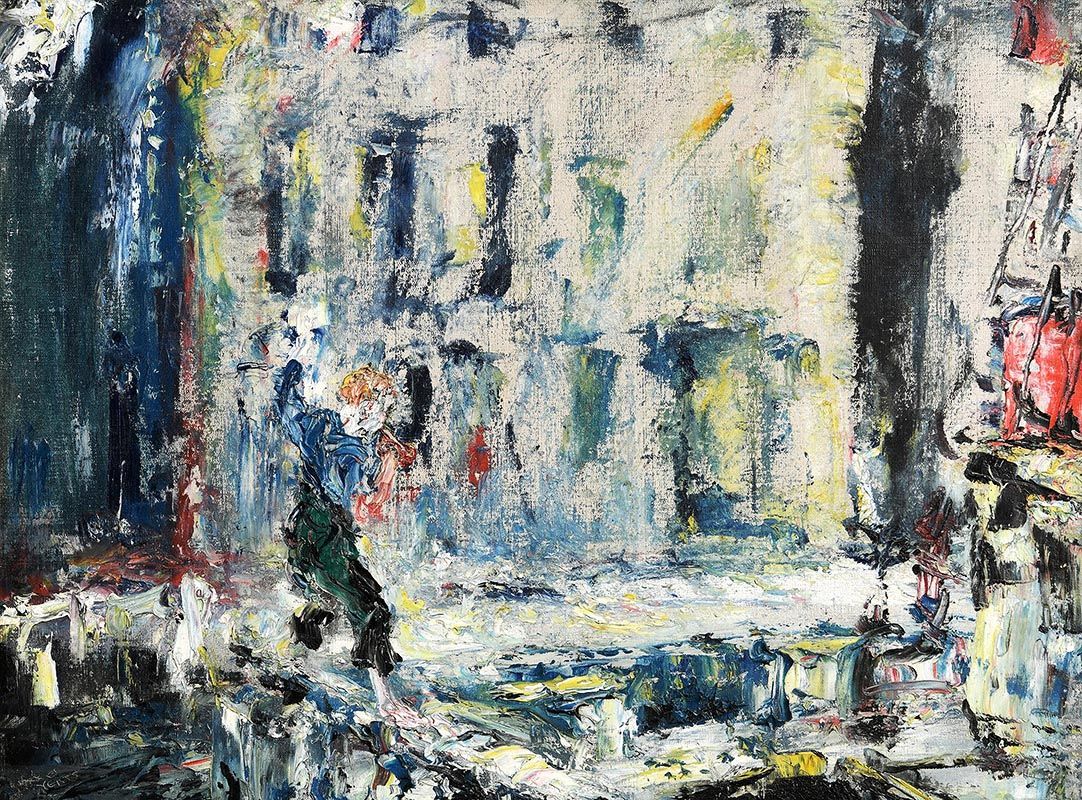
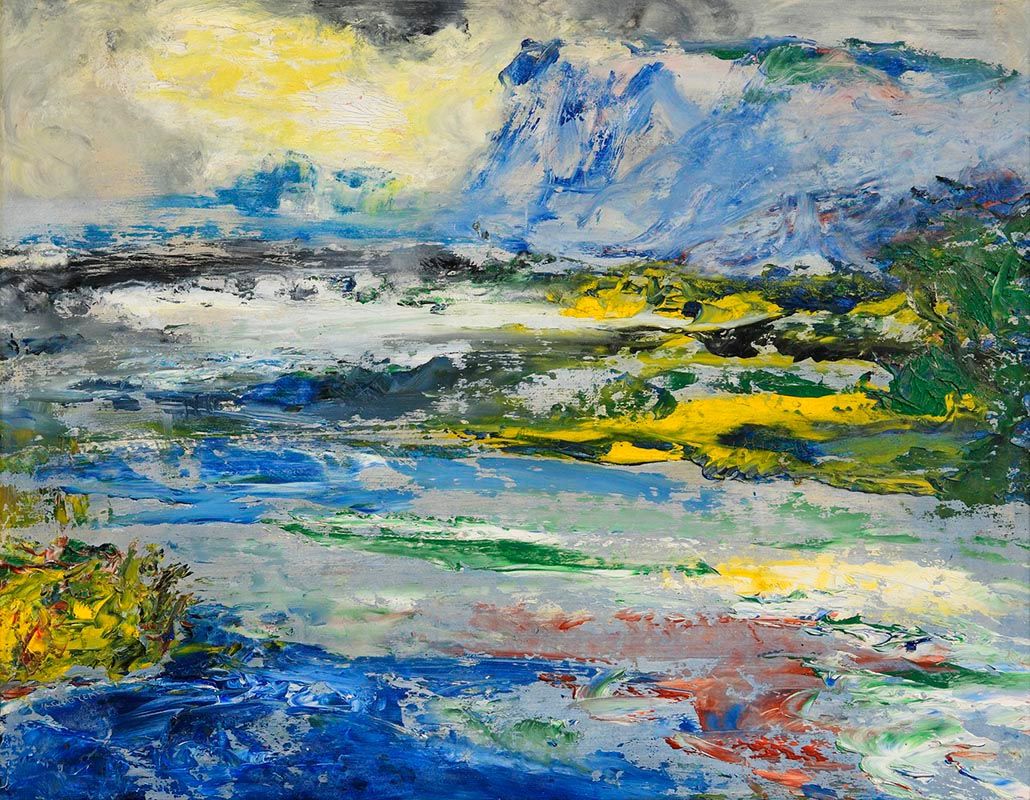
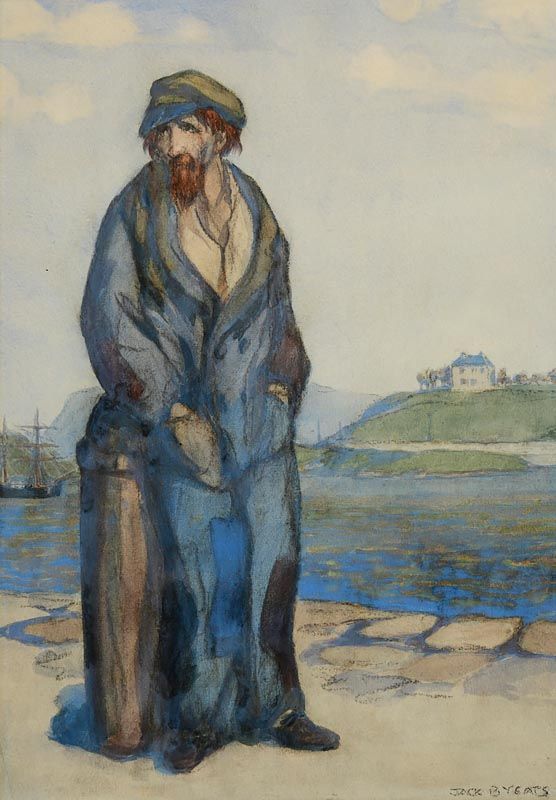

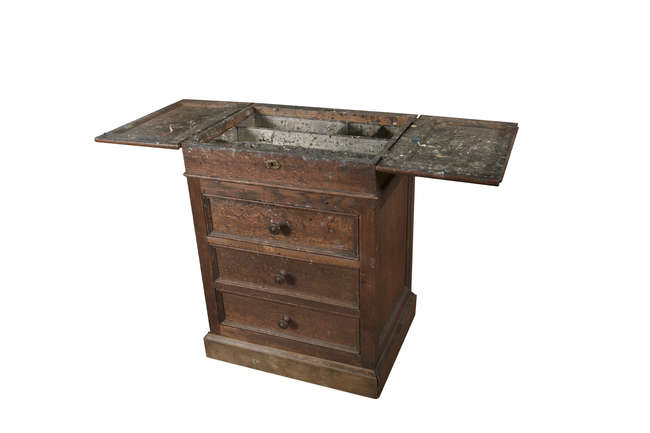
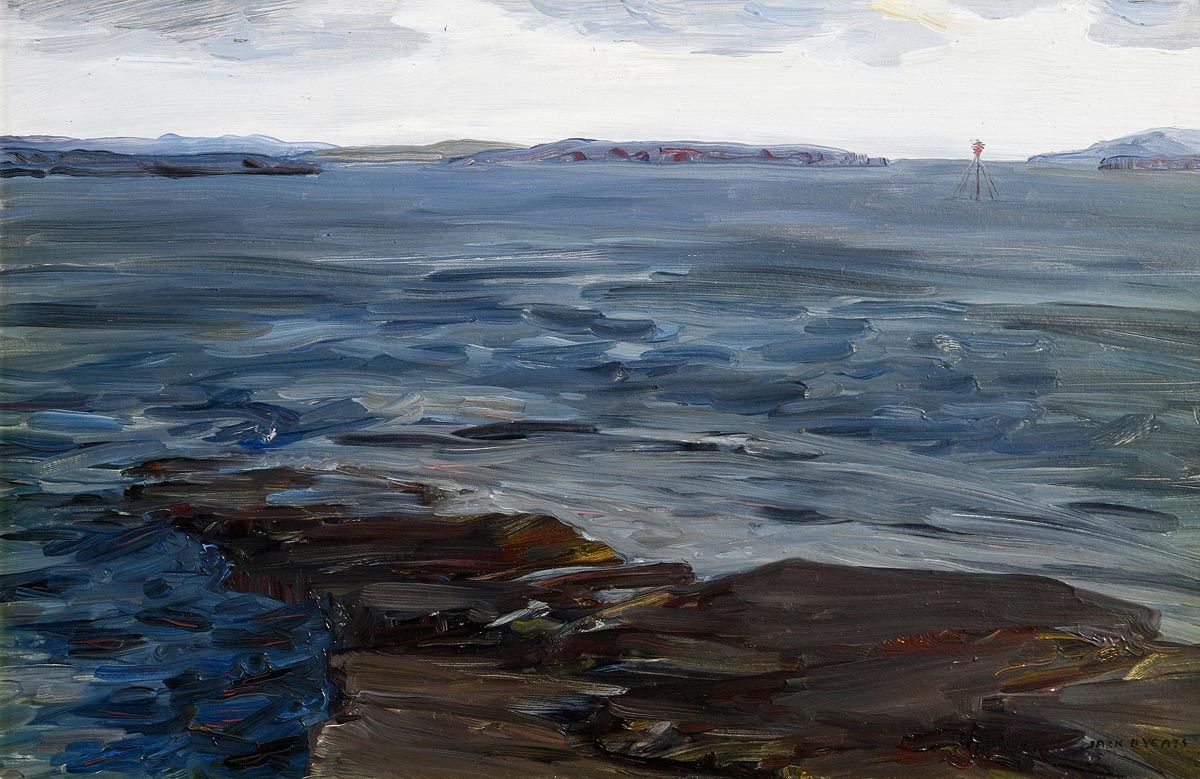
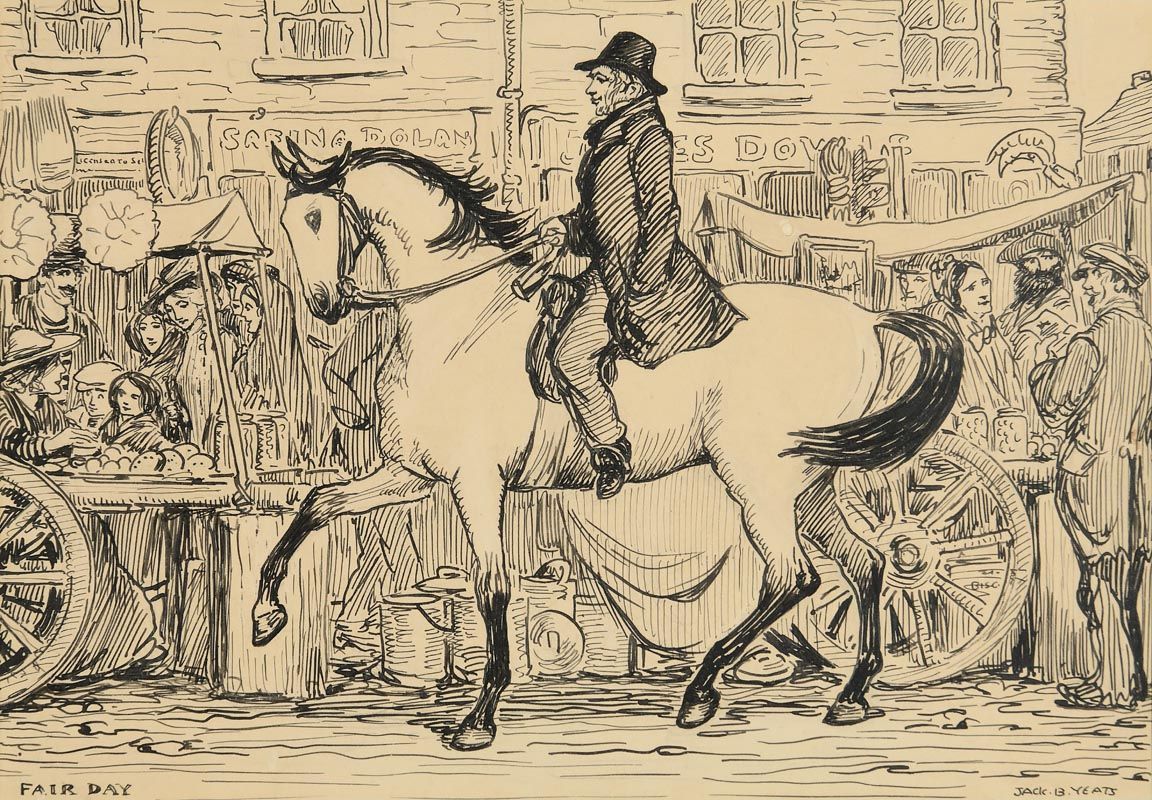
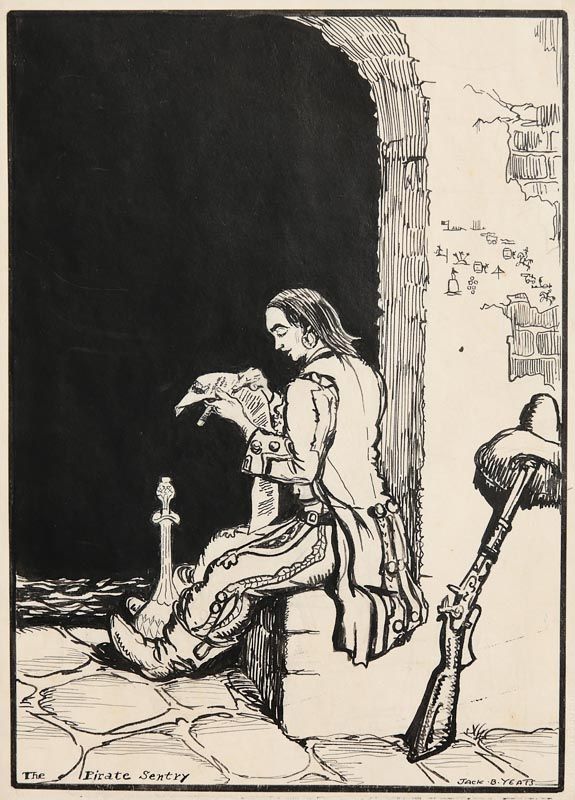


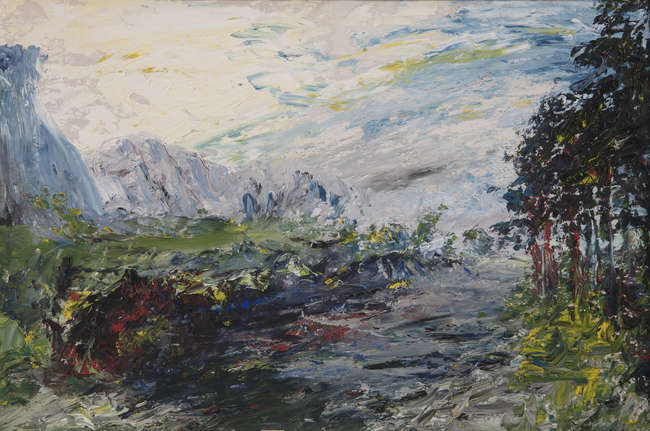
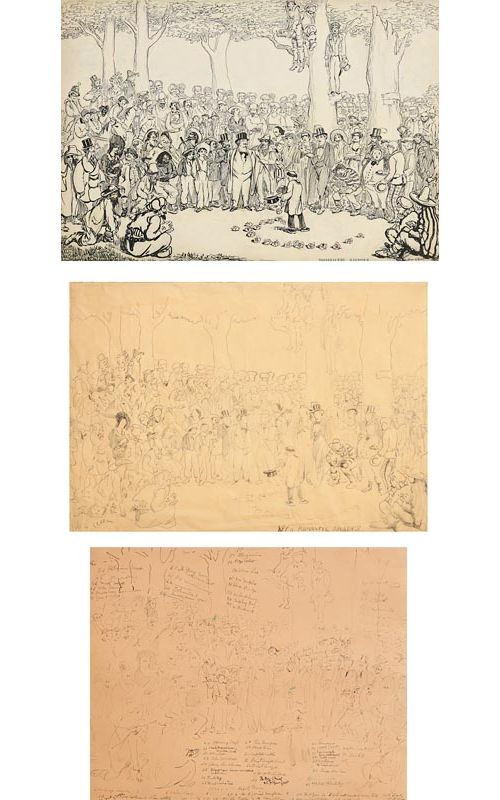
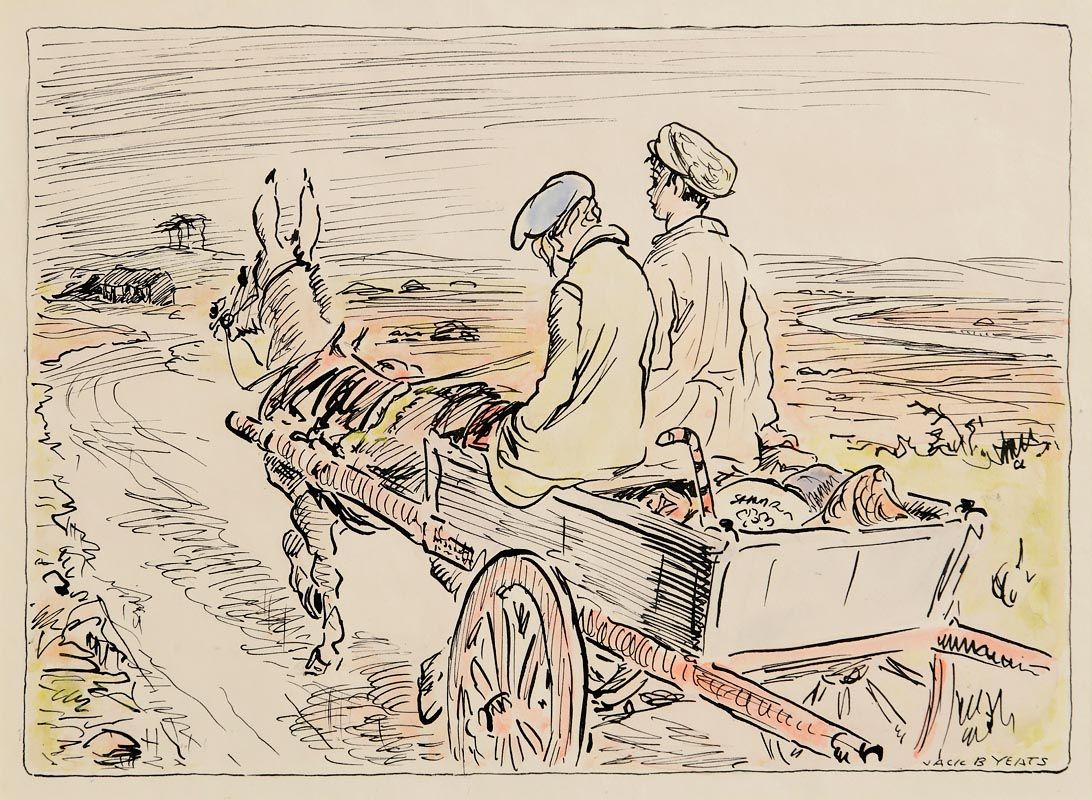

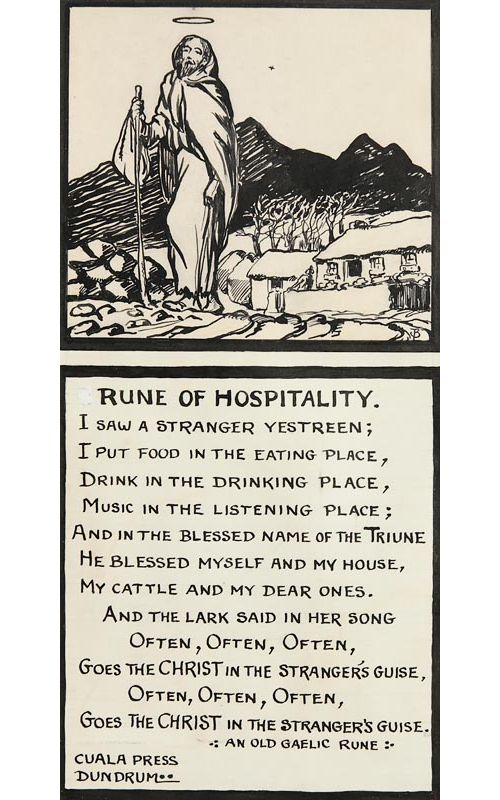
Try LotSearch and its premium features for 7 days - without any costs!
Be notified automatically about new items in upcoming auctions.
Create an alert